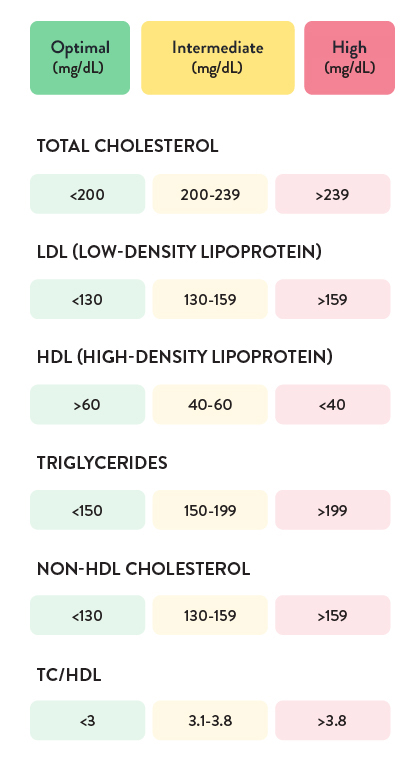Global Point Of Care


UNDERSTAND YOUR CHOLESTEROL NUMBERS AND HOW TO IMPROVE THEM
Welcome! Knowing your cholesterol numbers is the first step toward better heart health.
Your cholesterol test was completed on the Cholestech LDX™ Analyzer, a lipid screening device capable of producing lab-accurate results1 at your chosen point of care.
Now that you have your test results, find out what they mean using the chart below and then keep reading to see what you can do to improve them.
Lipid Profile Chart
A lipid profile is a test that measures the fats in your blood. It measures your total cholesterol, HDL cholesterol, LDL cholesterol, triglycerides, and non-HDL cholesterol.
If your lipid profile shows you have moderate (intermediate) to high cholesterol levels, your risk for heart disease and stroke is elevated, and some lifestyle adjustments and/or medication may be necessary to decrease your risk.
How do your cholesterol numbers measure up?



Cholesterol levels are measured in milligrams (mg) of cholesterol per deciliter (dL) of blood.
Cholesterol Terms Explained
Total Cholesterol
This is the accumulative amount of cholesterol in your blood. Your Total Cholesterol number is obtained by adding together your HDL, LDL, and 20% of your triglycerides numbers.
LDL (low-density lipoprotein)
Considered “bad” cholesterol because it contributes to fatty deposits in the arteries (atherosclerosis) that can lead to stroke, heart attack, or peripheral artery disease. The lower your LDL levels, the better.
HDL (high-density lipoprotein)
Known as “good” cholesterol, HDL removes cholesterol from your arteries and blood. The higher your HDL levels, the more beneficial it is to your health, helping to protect you against strokes and heart attacks. Desirable HDL levels are different for men and women.
Triglycerides
A type of fat, high levels of triglycerides in your blood can put you at risk of atherosclerosis and other diseases
Non-HDL cholesterol
This is a reading of all the cholesterol in your blood that isn’t “good” HDL, obtained by subtracting your HDL number from your Total Cholesterol. High levels can increase your risk of atherosclerosis and heart disease.
TC/HDL
This is a ratio of Total Cholesterol divided by HDL cholesterol, which is sometimes used to assess heart disease risk. Lower ratios are associated with lower risk.


How can I lower my cholesterol levels naturally?
Although medication can help improve your cholesterol, your physician may prefer you try to lower your cholesterol naturally.
These healthy lifestyle changes, recommended by the American Heart Association, may help you reduce your cholesterol and risk of cardiovascular disease and stroke. Even if you’re already on medication, these changes can improve its effectiveness.
Eat a heart-healthy diet
Create a nutrition plan that includes heart-healthy foods. Knowing what to eat and how to prepare it is vital to a heart-healthy diet.
Eat more of these heart-healthy foods
1. Fatty fish (salmon, sardines, mackerel)
2. Nuts, oats, barley
3. Fruits, berries, avocado
4. Dark chocolate & cocoa
5. Leafy greens, vegetables, beans, lentils, soy
6. Garlic and virgin olive oil
7. Green tea
Avoid eating these foods
1. Red meats (pork, beef, lamb)
2. Full-fat dairy products (butter, cream)
3. Baked goods and sweets
4. Fried foods
5. Tropical oils like palm and coconut oil
Cholesterol levels are greatly affected by what you eat. The American Heart Association has helpful guidelines for cooking and eating healthy.
Eliminate tobacco and
limit alcohol
Stop smoking, vaping, and tobacco use.
Drink in moderation.
Exercise regularly
Get 150 minutes of moderate-intensity aerobic activity or 75 minutes of vigorous aerobic activity, or a combination of both spread throughout the week.
Examples of moderate-intensity aerobic activities include: brisk walking, water aerobics, gardening, biking slower than 10 mph.
Examples of vigorous aerobic activities include: hiking uphill, running, swimming laps, aerobic dancing, tennis, cycling faster than 10 miles per hour.
Lose weight if necessary
Achieve a healthy weight through diet and exercise. The body mass index (BMI) scale is widely used to determine healthy weight based on factors like height and age. The healthy BMI range is the same for men and women and falls between 18.5 and 25 kg/m2.
Find your BMI using the calculator here.
Reduce stress in your life
Form healthy sleeping and relaxation habits to keep stress at bay.
Always consult with your physician/healthcare provider before making any dietary changes or beginning any exercise or weight loss program.
Frequently Asked Questions
How does cholesterol cause heart disease and stroke?
Cholesterol is a waxy substance that circulates in your bloodstream. It can join with other substances to form a thick, hard deposit inside your arteries, narrowing themand making them less flexible. This condition is called atherosclerosis. If a blood clot forms and blocks one of these narrowed arteries, a heart attack or stroke can occur.
How often should I check my cholesterol?
The American Heart Association recommends that all adults 20 or older have their cholesterol and other traditional risk factors checked every four to six years, as long as their risk remains low. People with cardiovascular disease, and those at elevated risk, may need their cholesterol and other risk factors checked more often.
My test results also include a glucose score. What is it and what does it mean?
In addition to a lipid profile test, your provider may have also run a panel that includes glucose. Glucose is a measure of the sugar level in your blood. If levels are too high, it can lead to serious health problems like diabetes. Fasting glucose levels should be below 100 mg/dL. A score of 126 mg/dL or higher may indicate diabetes.
How does diabetes affect cholesterol?
Diabetes tends to lower "good" cholesterol levels and raise triglycerides and "bad" cholesterol levels, increasing the risk for heart disease and stroke. This is known as diabetic dyslipidemia. It's a condition that puts people at risk for premature coronary heart disease and atherosclerosis.
Is it possible to inherit high cholesterol?
Yes. Familial hypercholesterolemia (FH) is an inherited genetic defect affecting 1 in 250 people, but only about 10% know they have it. People with FH are essentially born with a genetic condition that predisposes them to high LDL (bad cholesterol), which contributes to a much higher risk of coronary heart disease. If left untreated, these people have 20 times the risk of developing heart disease. The good news is that FH is treatable with a combination of lifestyle changes and medications.
How is familial hypercholesterolemia (FH) diagnosed?
FH is diagnosed most often by a combination of physical exam and lab results, as well as personal family history. Children at increased risk of FH should be screened beginning at age 2. Risk factors for children include:
- Family history of early cardiovascular disease (less than 55 years for men and less than 65 years for women)
- Family history of total cholesterol of 240 mg/dL or above
- Obesity or other metabolic risk factors
All children, regardless of risk factors, should be screened between the ages of 9 and 11, and again between the ages of 17 and 21.
Do I need medication to control my cholesterol?
For some people, healthy lifestyle changes may be enough to lower their cholesterol to healthy levels. For others, medication may be required in addition to these changes. Your doctor can evaluate you to determine which medication is best for you, should you need it.
There are many types of medications that lower cholesterol but the most common of these are called statins. Statins reduce the risk of heart attack and stroke by raising levels of HDL (good cholesterol) and lowering the levels of LDL (bad cholesterol) and triglycerides in the blood.
This web page references information from the American Heart Association and American Diabetes Association websites: https://www.heart.org/ and https://diabetes.org/ respectively.
REFERENCE: 1. Abbott. Cholestech LDX™ System: The accuracy and reproducibility of a rapid fingerstick method for measuring a complete lipid profile is comparable to clinical diagnostic laboratory methods. Technical brief. August 2019.




